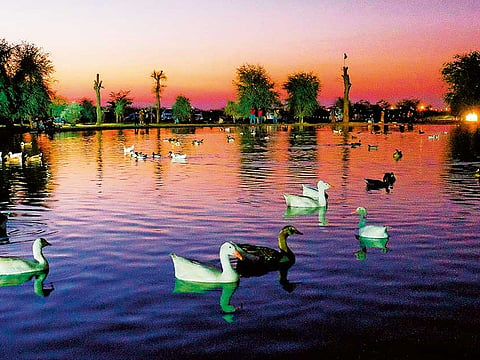Al Qudra Lakes: The new haven for exotic birds
Popular picnic destination is now home to nearly 180 species of birds including some endangered ones, says wildlife expert

Dubai: The Al Qudra Lakes is fast emerging as the perfect habitat for migratory and resident birds with nearly 180 species thriving in the popular picnic destination.
After doves, bulbuls, bee-eaters, sandpipers, plovers, herons and lapwings, the place is now home to the Indian Moorhen, a medium-sized water bird of the rail family (Rallidae).
“Barely five years ago there were hardly any moorhens here. Today, there are more than 50 of them,” says Dr. Reza Khan, principal wildlife specialist, Dubai Safari, Recreational Facilities Department - Dubai Municipality.
Another waterbird that has made Al Qudra Lake its home in recent years is the Little Grebe.
“There are about 30 of them and the numbers are rising,” said Khan, who has been recording the number of bird species in the area since 2008.
New sightings
Similarly, there have been several sightings of the Red Wattled Lapwing, a species of wetland bird. “These birds usually occur in pairs and we have found several of them breeding here. Red Wattled Lapwings are large waders. Their wings and back are light brown with a purple sheen, but head and chest and front part of neck are black. A broad white stripe extends from each eye down the sides of the neck, drawing a clear line between the black and brown plumage. When in flight, the white rump and tail can also be seen with a broad black band extending across the tail,” said Khan. Another long-legged wading bird - Avocet – with a slender upturned bill and strikingly patterned plumage -- has also winged its way to Al Qudra. “We have spotted 13 of them so far,” he added. Then there are the Northern Shoveler and Great Cormorant. Around 300 Shovelers and 400 Cormorants have migrated here from Northern Europe and Central Asia.
Spread over 10 hectares in the middle of the Saih Al Salam Desert, the man-made Qudra Lake is supplied with sewage treated water by the Jebel Ali sewage treatment plant of Dubai Municipality.
The abundance of fish in the lakes and presence of algae and reed beds along their banks make the place the perfect spot for birds to breed.
Dense foliage
The periphery of the Lakes is covered with several indigenous and exotic trees planted by the Dubai Municipality. Among them are Ghaf Prosopis cineraria, Acacia Ehrenberghiana Acacia farnesiana, Acacia A arabica, Ziziphus spinachristi, Ziziphus jujuba, Albizzia lebbek, Pithecellobium dulcis, Parkinsonia aculeata to name a few. A drip irrigation system waters the plants around the lake.
In addition to the various species of birds, Dr Khan and his team have also recorded 73 species of plants, 26 species of reptiles and 12 species of mammals.
The number of species of insects and other invertebrates, however, is yet to be assessed. said Khan.
Sign up for the Daily Briefing
Get the latest news and updates straight to your inbox


